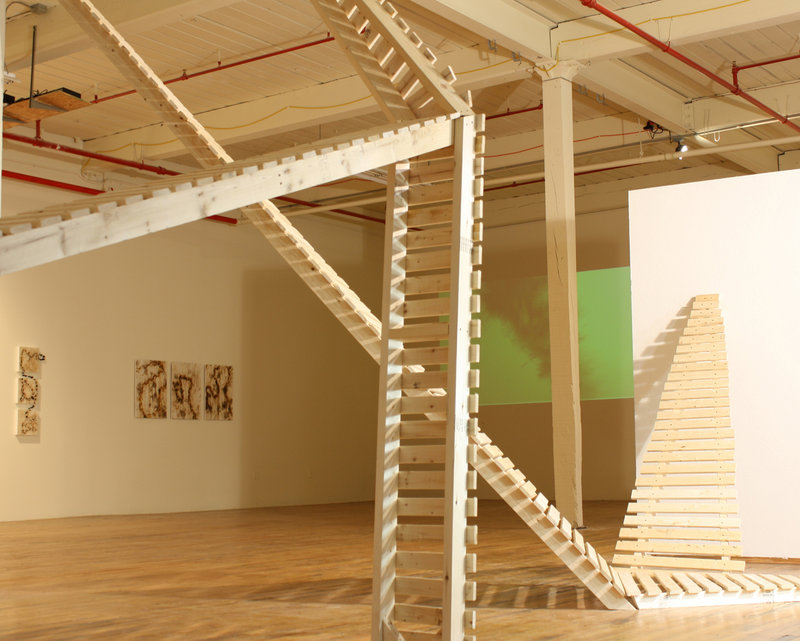Richard Keen’s “Nowhere from Here” at the Coleman Burke Gallery in Brunswick is an excellent installation. It’s engaging, interesting and accessible, despite Keen’s philosophical depth.
Keen’s coastal tool imagery is largely divided between chains and wharfs. Chains appear as rusted residue on large paper drawings, as sculpted forms, and as images in a set of spare underwater videos shot by the artist.
The wharfs are most poignantly rendered by a group of spatially rowdy wooden structures that climb, dive and reach through the gallery with an Escher-like disdain for rationality.
Coleman Burke Gallery is one of the most beautiful art spaces in Maine, but it is also one of the most daunting. It’s a vast, gymnasium-sized room in an old mill. “Nowhere from Here” succeeds because not only does it use the floor and the walls, it also mobilizes the very volume of the gallery to make its points and further the viewer’s experience.
Four of Keen’s works on paper reach for the 18-foot ceiling. The images of chains rendered in rust immediately bring the idea of flat works on flat walls into play. Egged on by a large video shot while following a chain through murky green depths of Maine’s coastal waters, the chain imagery presses you to see yourself within a volume of water.
This is further supported by the wharf structures that fade to a point when reaching to the ceiling. The attenuation plays up the ideas of distance as perception, and of the ceiling as the water’s surface above you.
The gallery space as underwater volume is reinforced and clarified by a 5-foot box tent in which you are invited to lie on your back to view a first-person underwater video shot by a diver following a mooring chain. Glowing from the gallery’s ambient light, the tent almost perfectly matches the green on the screen. The effect is effervescently dizzying — moving in space in the water is not like moving on land, where gravity is a one-way anchor.
I particularly like that Keen’s basic ideas are easily accessible while also opening doors to complex lines of philosophical inquiry. Comparing the space of the gallery to the volume of a body of water becomes very interesting when considering them as places where people move about, both in practical and experiential terms.
Keen’s pictorial imagery in this show also presses experiential and epistemological points. He appears to have put wet and rusty chains flat on the paper while it was on the ground rather than rendering the illusion of chains suspended in water. Whether Keen painted with the rust or used actual rusty objects hardly matters; their map-like topographical logic is evident.
Keen is known for paintings about natural and man-made geometries relating to coastal culture. But his pictures in “Nowhere from Here” follow a more practical sea-floor mode of residue and trace rather than image. These are not as aesthetically appealing as Keen’s better-known paintings, because they leave behind standard technique to achieve smart and interesting conceptual content.
I am guessing the 25 panels and drawings are the complete body of Keen’s “naturalistic” pictures because of the clear development from the smaller, less assured and heavier-surfaced paintings to the confident and economical “Large Drawings.” Some of the works feature painted Styrofoam “chains” attached directly to the wall that wander in and out of them, and the refinement of this feature is also apparent.
In philosophical terms, Keen’s work is fundamentally dialectical. He has a thesis (land) and an antithesis (sea), and he resolves the dialectic with a mediating term — the wharf. While I don’t want to chase away anyone through explaining how Keen uses a Hegelian rather than Classical dialectic throughout “Nowhere from Here,” what matters is that he has mastered and employed a philosophically sound epistemological method.
Like a good piece of music, however, you don’t have to parse it. It’s enough for us to just feel it makes sense.
This comfortable sensibility carries over from Keen’s paintings, which tend to make the point that human structures almost always model themselves on organic logic. The curves of boats, for example, match the curves of shells and the growth patterns in trees. This organic logic is less obvious in this installation, yet it’s unavoidable. The wooden wharfs are raw wood, and the tree metaphor, while subtle, never disappears — nor do the modular repetitions with their echoes of microscopic life, tree growth, shells or bone systems.
If you feel lost without clear this-means-that metaphors, then “Nowhere from Here” could seem too ungrounded to you. After all, Keen poignantly questions what we know from our physical experience of the world. But he offers the insights of a professional diver as well as a seasoned artist.
Personally, I prefer shows like this — where the philosophical floodgates gush with content and don’t skimp on conceptual possibilities. That why I think that among Coleman Burke’s many great shows, this is one of the best.
Freelance writer Daniel Kany is an art historian who lives in Cumberland. He can be contacted at:
dankany@gmail.com
Copy the Story Link
Send questions/comments to the editors.



Success. Please wait for the page to reload. If the page does not reload within 5 seconds, please refresh the page.
Enter your email and password to access comments.
Hi, to comment on stories you must . This profile is in addition to your subscription and website login.
Already have a commenting profile? .
Invalid username/password.
Please check your email to confirm and complete your registration.
Only subscribers are eligible to post comments. Please subscribe or login first for digital access. Here’s why.
Use the form below to reset your password. When you've submitted your account email, we will send an email with a reset code.